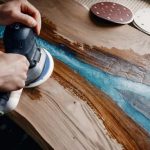Woodworking is a craft that requires precision and attention to detail. One crucial aspect of this craft is accurately measuring angles, as even the slightest miscalculations can lead to flawed results. Whether you are a beginner or an experienced woodworker, understanding where to measure for angle woodworking is key to achieving flawless results in your projects.
Accurate angle measurements play a vital role in ensuring the structural integrity and aesthetic appeal of woodworking projects. From creating perfectly aligned joints to achieving precise bevels and compound cuts, knowing how to measure angles correctly is essential for any woodworker. Without accurate measurements, projects can quickly go awry, resulting in wasted time, materials, and frustration.
To measure angles effectively in woodworking, specific tools are needed. Protractors, angle finders, bevel gauges, and combination squares are just a few of the essential tools that will aid in precise angle measurements. Each tool has its unique features, advantages, and limitations for different woodworking tasks. Choosing the right tool based on your project requirements is crucial in obtaining accurate measurements.
In the following sections of this article, we will explore various aspects of measuring angles in woodworking. We will discuss the basic tools necessary for accurate measurements and provide tips for selecting the right tool based on project requirements. Additionally, we will delve into identifying key points for angle measurements and offer techniques for locating these points effectively. By mastering these fundamentals, woodworkers can lay the foundation for meticulous craftsmanship and flawless woodworking results.
The Basic Tools Needed for Measuring Angles in Woodworking
When it comes to woodworking, accurate angle measurements are crucial for ensuring precision and achieving the desired results. To achieve this level of accuracy, you need to have the right tools for the job. In this section, we will discuss the essential tools needed for measuring angles in woodworking and explore their features, advantages, and limitations.
Protractors
One of the most commonly used tools for measuring angles in woodworking is the protractor. Protractors come in various designs and are available in both digital and analog versions. They are perfect for measuring angles up to 180 degrees accurately. The analog protractor typically has a rotating arm with a scale that allows you to measure angles by aligning it with the edge or corner of your project.
Digital protractors, on the other hand, provide precise angle measurements with a digital display. These modern protractors often feature additional functions such as hold buttons and lockable arms to ensure accurate readings. However, it’s important to note that digital protractors may require batteries and can be more expensive than their analog counterparts.
Angle Finders
Another tool commonly used in woodworking for measuring angles is an angle finder. Angle finders are useful when you need to determine an unknown angle or match an existing one precisely. They typically consist of two arms joined by a hinge that allows them to pivot freely. Angle finders are easy to use; simply place one arm against one surface and adjust the other arm until it matches the angle you’re trying to measure.
Angle finders come in different designs such as magnetic ones which attach firmly to metal surfaces, making them suitable for metalwork as well. Some models also feature bubble vials or levels that help ensure accuracy during measurements.
Bevel Gauges
A versatile tool for measuring and transferring angles in woodworking is the bevel gauge. Bevel gauges usually consist of a handle attached to a sliding blade that can be locked at any angle. They are commonly used for layout work, allowing you to transfer an angle from one piece of wood to another with ease.
Bevel gauges are beneficial for tasks such as marking angles for mitered joints or creating consistent slopes on projects. They are compact, easy to use, and often have clear markings for accurate readings. However, their limitations lie in measuring smaller or more obtuse angles accurately.
Combination Squares
When it comes to woodworking, combination squares are indispensable tools that have multiple uses, including measuring angles. Combination squares consist of a ruler and a headstock that can be adjusted and locked at different angles.
The ruler on a combination square provides precise measurements, while the headstock allows you to determine and set specific angles easily. Combination squares come in various sizes and materials; however, it’s recommended to choose a high-quality square with clear markings and tight locking mechanisms for accurate angle measurements.
Identifying Key Points for Angle Measurements
When it comes to accurate angle measurements in woodworking, identifying key points is crucial. These key points serve as reference markers and starting positions for measuring angles. By understanding how to locate these points effectively, woodworkers can ensure precise and consistent measurements throughout their projects.
In woodworking, key points are specific locations on the workpiece that help determine the angle being measured. Some common key points include edges, corners, and joints. By properly identifying and marking these points, woodworkers can accurately measure angles and achieve the desired results.
To locate key points for angle measurements, there are a few practical techniques you can follow:
- Use dividers or a marking gauge: Dividers or a marking gauge can be used to transfer measurements or find equal distances from one point to another. By adjusting the dividers or marking gauge to the desired measurement, you can mark multiple equidistant reference points along an edge or corner.
- Utilize squares and straightedges: Squares and straightedges are invaluable tools for woodworking. They can be used to create perpendicular lines and establish right angles at key locations on the workpiece. By aligning the square or straightedge with an edge or corner, you can easily locate key points for angle measurements.
- Employ templates or jigs: Templates and jigs are helpful tools for repetitive tasks in woodworking. They can be used as guides to quickly locate key points on multiple workpieces. Templates allow for consistent placement of markers, ensuring accurate angle measurements across various pieces.
By employing these techniques, woodworkers can confidently identify and mark key points for angle measurements in their woodworking projects. This ensures accuracy and precision when measuring angles, leading to flawless results in their craftsmanship.
| Key Points | Significance |
|---|---|
| Edges | Helps determine the angle between two adjacent surfaces or edges |
| Corners | Serves as a reference point for measuring angles formed by intersecting surfaces |
| Joints | Aids in measuring angles involved in joining different pieces together |
Measuring Angles in Common Woodworking Scenarios
Measuring angles accurately is crucial in woodworking to ensure precise cuts and joints. In this section, we will discuss some tips and tricks for measuring angles in common woodworking scenarios with utmost accuracy.
1. Measuring 90-Degree Angles: One of the most common angles in woodworking is the 90-degree angle, which forms a perfect right angle. To measure a 90-degree angle, you can use a combination square or a speed square.
Place one arm of the square against one edge, aligning it with the reference point. Then, slide the other arm along the adjacent edge until it meets perfectly at 90 degrees. Make sure to tighten any locking mechanisms on your square to maintain accuracy throughout your measurements.
2. Measuring 45-Degree Angles: Another frequently used angle in woodworking is the 45-degree angle, which is commonly found in mitered corners or chamfered edges. To measure a 45-degree angle, you can utilize an adjustable bevel gauge or an adjustable miter gauge. Set the gauge to 45 degrees and align it with one edge or corner of your workpiece. Ensure that both arms of the gauge are tight against their respective edges while making your measurement.
3. Measuring 30-Degree Angles: Sometimes, you may need to measure or create a 30-degree angle for specific projects such as constructing hexagonal shapes or tapered legs. For measuring this kind of angle, you can use a protractor or a digital angle finder precisely adjusted to 30 degrees.
Align one side of the protractor’s base with an edge and position the center pointer at the reference point while keeping it steady with your other hand. Read off the degree markings at the intersecting line to get an accurate measurement.
Remember to take these measurements from both sides of your workpiece as doubling up on your measurements helps ensure accuracy. Additionally, using a sharp pencil or a scribe to mark your measurements will make it easier to reference them later during the woodworking process.
By following these tips and utilizing the appropriate tools, you can measure angles accurately in common woodworking scenarios. However, it’s important to keep in mind that practice makes perfect. Regularly honing your angle measurement skills through projects and exercises will significantly improve your accuracy and craftsmanship in woodworking.
Advanced Angle Measurement Techniques
Woodworking often involves more than just basic angle measurements. As you progress in your woodworking journey, you may encounter complex projects that require advanced angle measurement techniques. These techniques include measuring compound angles, dovetails, and mitered joints.
One of the most common advanced angle measurement techniques is measuring compound angles. Compound angles are angles that have both a horizontal and vertical component. This type of angle measurement is essential for projects such as roof framing, staircases, and furniture with angled joinery.
To measure compound angles accurately, specialized tools like a sliding bevel or digital inclinometer can be used. The sliding bevel consists of two blades which can be adjusted independently to match the desired angles. On the other hand, digital inclinometers provide precise angle measurements with digital displays.
Another complex angle measurement technique is measuring dovetails. Dovetail joints are widely used in fine woodworking for their strength and durability. Measuring dovetails requires skill and precision to ensure a perfect fit between the tails and pins.
For measuring dovetails accurately, a dovetail marker or marking gauge can be helpful tools. These tools typically have angled sides that allow for consistent marking of both pins and tails. Additionally, a double square can assist in ensuring the sides of your dovetail cuts are perfectly perpendicular to your project piece.
Mitered joints are another common challenge that requires advanced angle measurement techniques. These joints are commonly seen in picture frames and trim work where two pieces of wood meet at an angled corner.
To measure mitered joints accurately, a miter gauge or miter square can be used. A miter gauge allows you to accurately set the desired angle on your table saw or other power tools for cutting precise miters. Alternatively, a miter square provides an accurate reference for checking or marking 45-degree angles by aligning it against two adjacent faces.
Avoiding Common Mistakes in Angle Measurement
Achieving accurate angle measurements is crucial in woodworking, as even a slight miscalculation can lead to flawed results. To ensure precision, it’s important to be aware of common mistakes that beginners often make when measuring angles and how to overcome them.
One common mistake is failing to position the measuring tool correctly. When using tools like protractors or combination squares, it’s essential to align them properly with the edges or corners of the workpiece. Failing to do so can result in erroneous angle readings. To avoid this mistake, take your time to ensure that the tool is securely positioned before taking any measurements.
Another pitfall is relying solely on visual estimation. Many beginners tend to trust their eyes when assessing angles, which can lead to inaccuracies. To overcome this mistake, it is recommended to always use precise measuring tools such as angle finders or bevel gauges. These tools provide accurate numerical readings, leaving no room for guesswork.
Using incorrect measurement units is also a common error. It’s important to be consistent with the units of measurement throughout the woodworking project. Whether you are working with degrees or radians, using the wrong unit can throw off calculations and result in incorrect angles. Take care to double-check your units and make sure they align with the specific requirements of your project.
Double-checking measurements is imperative in woodworking, yet many beginners neglect this step. Inaccurate angles not only affect the final product but also jeopardize subsequent steps in the woodworking process. To avoid this mistake, always take multiple measurements from different key points and compare them for consistency. If there are discrepancies, recheck your tool positioning or consider using a different method for increased accuracy.
By being mindful of these common mistakes and implementing strategies to overcome them, woodworkers can improve their angle measurement skills significantly. Remember that practice makes perfect – regular practice, combined with attention to detail and the use of reliable measuring tools, will greatly enhance your woodworking accuracy.
Incorporating Angle Measurements Into Woodworking Calculations
Woodworking involves precise calculations to ensure the desired outcome of a project. This section will focus on how angle measurements are used in various woodworking calculations, providing formulas and examples to guide woodworkers toward precision.
Understanding the Role of Angle Measurements
Angle measurements play a crucial role in a wide range of woodworking calculations. They are essential for determining lengths, bevels, compound cuts, and various other aspects of woodworking projects. For example, when cutting a bevel edge on a board, the angle measurement determines how much material needs to be removed to achieve the desired result. Similarly, when calculating compound cuts for mitered joints or dovetail joinery, accurate angle measurements are crucial for achieving seamless fits.
The Formulas for Calculating Measurements Based on Angles
To incorporate angle measurements into woodworking calculations accurately, it is important to understand the relevant formulas and their applications. One fundamental formula used is the tangent function (tan), which relates the angle measurement to the ratio of two sides of a right triangle.
For example, when calculating the length of a board based on an angle measurement, you can use the equation:
Length = Hypotenuse ÷ cos(angle).
Similarly, when determining bevel angles for cutting edges or joining pieces at specific angles, you can use:
Bevel Angle = arctan(tan(angle) × sin(reference angle)).
These formulas provide a solid foundation for performing accurate woodworking calculations based on angle measurements.
Tips for Seamlessly Integrating Angle Measurements
Integrating angle measurements seamlessly into woodworking plans and projects requires attention to detail and careful consideration. Here are some tips to help woodworkers achieve precision:
- Double-Check: Always double-check your measurements before making any cuts or carrying out any operations. Accurate angles are essential for the success of your woodworking project.
- Consistent Units: Ensure that all measurements used in your calculations are in the same unit (e.g., inches or centimeters) to avoid any discrepancies.
- Use Digital Tools: Consider utilizing digital tools such as smartphone apps or online calculators that can simplify complex angle calculations and provide accurate results.
By following these tips and leveraging the formulas provided, woodworkers can seamlessly incorporate angle measurements into their woodworking calculations, ultimately achieving precision and flawless results in their projects.
Practice Makes Perfect
To truly master angle measurements in woodworking, there’s no better way to improve than through practice. By engaging in projects and exercises that focus on honing your angle measurement skills, you can enhance your precision and craftsmanship. This section will provide a guide to help you practice effectively.
One practical woodworking project that can help improve your angle measurement skills is building a picture frame. Picture frames often require precise miter joints, making it an excellent exercise for mastering angle measurements. Start by selecting the appropriate tools, such as a combination square or miter gauge, to ensure accurate angles.
Measure and mark the angles for each corner of the frame, ensuring they are all equal to achieve perfect corners. Assemble the frame using clamps or other fastening methods, double-checking each joint before finalizing.
Another great exercise is creating angled cuts on scrap wood. This exercise allows you to practice measuring and cutting different angles accurately. Start by choosing various angles, such as 30 degrees or 45 degrees, and use tools like a bevel gauge or protractor to measure and mark them on the wood. Then carefully cut along the marked lines using a saw or another suitable tool. Repeat this exercise with different angles to further refine your skills.
It’s important to remember that practicing regularly is key to improving your angle measurement skills in woodworking. Set aside dedicated time each week for practicing different techniques and projects that involve precise angle measurements. Take note of any difficulties or challenges you encounter during these practice sessions and seek solutions online or from experienced woodworkers.
By consistently honing your angle measurement skills through various projects and exercises, you’ll gradually notice improved accuracy in your woodworking endeavors. Remember that embracing mistakes as learning opportunities is crucial for growth as a woodworker. Keep exploring new techniques and projects that challenge your abilities with angles, allowing you to enhance both your craftsmanship and passion for woodworking.
Conclusion
In conclusion, accurate angle measurements are crucial for achieving flawless woodworking results. Throughout this article, we have discussed the importance of understanding key points, using the right tools, and employing various techniques to measure angles effectively. By applying these principles and honing your skills through practice, you can elevate your craftsmanship to new heights.
We have explored the basic tools necessary for measuring angles in woodworking, including protractors, angle finders, bevel gauges, and combination squares. Each tool has its advantages and limitations, so it is essential to select the right one based on your project requirements. Additionally, we have highlighted the significance of identifying key points such as edges, corners, and joints when measuring angles accurately. By mastering these fundamentals and marking these points effectively, you lay a strong foundation for precise measurements.
Throughout this article, we have delved into various scenarios – from measuring basic angles like 90-degree and 45-degree to tackling complex woodworking techniques like compound angles and dovetails. By providing step-by-step instructions and practical examples, we aim to equip you with the knowledge needed to navigate these challenges successfully. Furthermore, we have addressed common mistakes in angle measurement and offered solutions to ensure accuracy every time.
Incorporating angle measurements into woodworking calculations is also vital for precision. We have explained how angles are used in determining lengths, bevels, and compound cuts. By providing formulas and examples throughout the article, we encourage you to seamlessly integrate angle measurements into your woodworking plans.
Finally, we emphasize that practice makes perfect when it comes to honing your angle measurement skills. By engaging in practical projects and exercises that require precise measurements, you can continually improve your craftsmanship over time. We urge you to apply the tools, techniques, and tips provided in this article as you continue exploring the world of woodworking angles.
Remember that mastering angle measurements is an ongoing journey that requires patience and dedication. By applying what you’ve learned here and maintaining a curious mindset, you can achieve stunning woodworking results that showcase your skill and passion. So, go forth, experiment with angles, and let your woodworking creations shine.
Frequently Asked Questions
Where do you measure angles?
Angles are measured using a protractor, which is a geometric tool specifically designed for this purpose. A protractor typically consists of a semicircular or circular piece of transparent plastic or metal divided into degrees or radians, with markings along its edge representing different angle measurements.
To measure an angle, the vertex of the angle is aligned with the center of the protractor, and then one looks at where the sides of the angle intersect the circular scale to determine its measurement.
How do you measure a 45 degree angle to cut wood?
To measure and cut a 45-degree angle in wood, there are several methods one can use depending on the tools available. One common approach is to use a miter saw. With a miter saw, you can adjust the cutting blade’s angle precisely to 45 degrees by using the markings provided on its base.
You align your wood piece against the fence of the miter saw and make your cut accordingly. Alternatively, if you don’t have a miter saw, you could use a combination square or speed square as guides while using a circular saw or hand saw to carefully cut along marked lines at 45 degrees.
What is the best way to measure an angle?
The best way to measure an angle depends on various factors like accuracy requirements and available tools. However, using a quality protractor is generally considered one of the most reliable methods for measuring angles accurately. When measuring an angle with a protractor, it is important to ensure that both arms of the angle intersect exactly at the center point of the protractor.
This ensures an accurate reading without any distortion caused by misalignment. Additionally, holding the protractor flat against a surface can also help provide more accurate measurements as it minimizes any potential errors caused by tilting or angling during measurement. It’s essential to take care when aligning and reading from a protractor to ensure precise measurements.

Hi everyone! I’m a woodworker and blogger, and this is my woodworking blog. In my blog, I share tips and tricks for woodworkers of all skill levels, as well as project ideas that you can try yourself.





